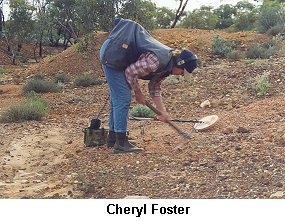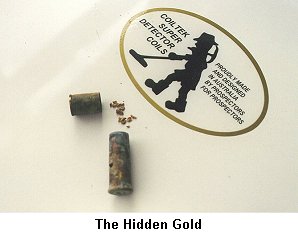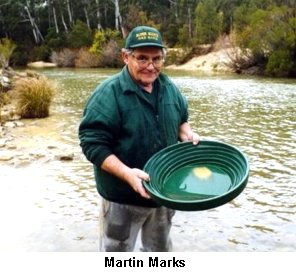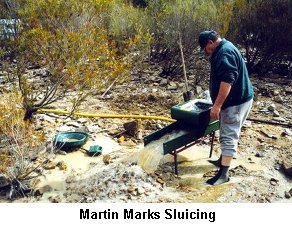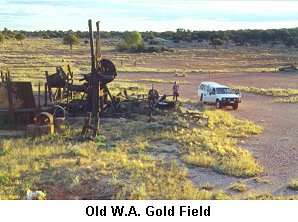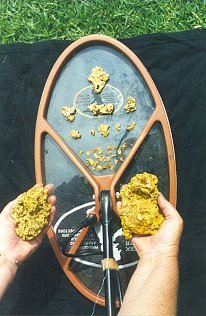
| November 2000 | |||||||||||||
|
|||||||||||||
Contents
|
|||||||||||||
1. EDITORIAL Gold Net Australia Online is proud to announce that a major Exposition will be held in Ballarat in March 2001- for the Gold Prospecting and Fossicking Industry. To be known as "The Australian Gold & Prospector's Expo", this will be a FIRST for the industry. In our first article this month we cover in more detail this spectacular Expo. It is indeed a major coup for Gold Net Australia. We are proud to be the major impetus behind this event. The Box Iron Bark issue is still of major concern to us all. There seems to be an attitude within some sectors within the Victorian Government, that "We know whats best, and you just be good little citizens - and do as you are told." Like hell we will. This issue could easily explode - as some sections of the community are extremely upset at the manner in which this issue has been handled, along with the "laise faire" attitude that permeates throughout those controlling the issue.
One could ponder the chaos if the recommendations contained in the consultants reports were adopted, and a determined group of disadvantaged people were to sue the consultants in the belief their report contains misinformation, mistakes, errors and misleading inaccurate data that has led to this particular group being disadvantaged as a result.
GEAR FOR SALE: If you have gear for sale - that relates to detecting, sluicing and associated products - we will list them for sale on a commission basis. There is no up front cost for you. Arrangement by private treaty. Editor Email: [email protected]
All material in this magazine is copyright and may not be reproduced in any part or form whatsoever without written permission from the publisher.
|
|||||||||||||
2. THE AUSTRALIAN GOLD & FOSSICKER'S EXPO by Brad Williams We are proud to announce the Inaugural "Australian Gold & Prospector's Expo" - to be held at the Ballarat Exhibition & Entertainment Centre, on the weekend of 17th - 18th March 2001. The fossicking industry throughout Australia is a huge, yet somewhat fragmented industry, due to the large distances between recognised gold fields, throughout Australia. For the first time ever - almost ALL the major participants will gather together in the same place at this time to display their goods and services. It will indeed be an exciting event - and one that is being strongly supported by the major players within the industry.
Several people within the industry recognised both the need and the potential for such an event to be a major success. Liaison and discussions have been long and protracted - to bring to those interested a fabulous display that will be talked about for decades to come.
Ballarat was selected as the best location to stage this event, due to its close proximity to the Gold Fields and to Melbourne.
This decision was made for a number of reasons. Firstly the year 2001 is the sesqui-centenary (150 yrs) of the discovery of Gold in Victoria. The Victorian government has appointed the Central Tourist Council of Victoria as the Project Managers coordinating all events relating to the celebrations. "Country Victoria Tourism Council as the project managers for the celebrations to mark the150th Anniversary of the Discovery of Gold support the, The Australian Gold and Fossicker's Expo. The CVTC recognise the value of this event and it's relevance to these celebrations."
There has also been support forthcoming from Events Ballarat & Beyond, the Local Government supported organisation in Ballarat, who will assist with promoting the event throughout the Gold Fields Region and Beyond. The industry will be represented by all facets, including the latest Metal Detectors, Sluicing Equipment, gem and faceting gear, along with a wide range of support equipment, including camping and four wheel drives. We selected the Ballarat Exhibition & Entertainment Centre as the most suitable venue. Its broad earthy appeal, with excellent facilities, both internally and externally, along with a responsive management team, make this venue one of the best in Victoria.
With an excellent snack food facility, along with an earthy bar, all those attending will be well catered for. Adjacent to this facility is the Quest Colony Apartments. An outstanding 4 1/2 star motel, providing excellent facilities, which includes an award winning restaurant, just 100 metres from the venue.
Minelab are strongly supporting the event by donating two of their sensational new GP Extreme Metal Detectors. One will be given away each day of the Expo. It will only require you to attend and fill out a form at their display to be eligible.
This will be a sensational Expo - and is the Inaugural event that will lead to even bigger and better Gold Prospecting and Fossicking Expo's in the future.
|
|||||||||||||
|
|||||||||||||
3. HISTORY IN HER HANDS byJim Foster Cheryl listened intently to the soft signal in her earphones. Swinging the 14" DD on her SD2200D gold detector first one way then the other she centered the signal. Satisfied she had the target pinpointed, she began to dig. It was a deep signal and halfway down to the target she was beginning to think it must be a nugget. All around were old dry blowing heaps where the oldtimers had patiently used wind and gravity to winnow the gold from the dry, dusty soil so it was a good chance it was gold.
With a loud "DON'T", I stopped her just in time. Taking the bullet shell from her I checked that I'd seen right, I had. It wasn't one, but two bullet shells. Wiping away the last of the dirt I found them to be a .45 calibre pistol shell and a .44 rifle shell. The open end of the .44 was jammed inside the .slightly larger open end of the .45.
Examining them closely I saw they were green with verdigri but still whole. They were no heavier than you'd expect them to be but when shaken they rattled. I smiled widely at a puzzled Cheryl as I heard the rattle, more of a tinkle really. I said, "I think you may have some gold here." With two pair of plies I gently gripped the rimmed and of each shell and carefully began to twist each shell in an opposite direction. They came apart fairly easily and without damage. Tipping the contents carefully into a gold pan we counted eleven tiny bits of gold, the stash of an old time prospector for his dry-blown gold. Gazing at the shells and the gold I imagined the original owner of that gold standing in the dusty East Murchison soil near Clifford Well laboriously dry blowing for gold, carefully hoarding each tiny speck. While the monetary value of the gold was less than ten dollars I think the historical value is priceless. We will never know who it was lost those shells but I can't help wondering: was it one of those greats of the early days McCauley, Sligo, Lucky Harry Swincer, Lawler, Ogilve, or even that legend from my own home town of Casterton Victoria, Tom Cue. Cheryl didn't know it when she dug those shells but she held a part of history in hands that day. The last person to hold those shells would have been the original owner perhaps one hundred years ago amid the dust and turmoil of a lively dry-blowing patch on the East Murchison goldfield in Western Australia.
|
|||||||||||||
|
|||||||||||||
4. PROFILE - MARTIN MARKS by Laurelle Murphy I always like a story with a happy ending. And telling this story is a great pleasure for me, as I always enjoy the company of Martin Marks. Martin's early life was one that was effected by the catastrophic events in Europe in the 1940's and 1950's. He was born in Slovenia, a part of Yugoslavia in 1934, and suffered with his family through the war years, as all Europeans did. At the conclusion of the Second World War, the Communist juggernaut of The USSR was heading towards its darkest years, and the Yugoslav Territories were closely allied with the Soviets.
Living in such deplorable circumstances forced Martin to make a decision to escape to the west, and so it was that in 1957, he decided to escape. By train to Maitland in New South Wales, and onto Greta, where an old army camp was his home for a month. He gained employment at Ivanhoe, in far west New South Wales, where for 6 weeks he worked as a carpenter, before making his way to Wollongong where he gained employment as a joiner. Six months later he moved to Sydney and from this time, has not really moved from the Sydney area. From late 1957 until 1965, Martin worked as an employee for three different firms, still working as a cabinet maker and carpenter. In 1964 Martin married Margaret, a woman he describes as a "real true Aussie girl." In 1965 Martin began his own business subcontracting, mainly working in domestic dwellings. Building homes, doing second fixing and replacing kitchens and the like. This was a successful period for Martin and in 1983, he formed a partnership with a friend and commenced a joinery business, which they successfully operated until 1993. Failing health forced Martin to relinquish his share of the business, as the dust particles were playing havoc with an ever worsening respiratory problem.
Since 1993 Martin has concentrated his efforts on his sluicing and panning business in Seven Hills, Sydney. During these last seven years, Martin has expanded his product range to be one of the finest in the world today. Martin enjoys the challenge of gold recovery and his knowledge of the creeks and streams throughout New South Wales is second to none. On the many occasions I have been with Martin sluicing or panning, I have always enjoyed the experience as we have always recovered gold, and good quantities of it on every occasion. His ability to find gold is uncanny, and his reputation is without peer.
In 1999 Martin won the Australasian Gold Panning Championship at Maryborough, and this year represented Australasia in Poland at the World Championships.
Martin has indeed made a major contribution to the industry and his products are now being exported to several overseas countries, including, South Africa, Austria, USA and New Zealand. This speaks volumes for his ability to produce quality sluicing and panning equipment. He is a true blue Aussie and is proud of his achievements. Martin can be contacted at his Seven Hills premises per phone on (02) 9838 0397. or visit at, Unit 3, 27 Anvil Road, SEVEN HILLS NSW 2147.
|
|||||||||||||
|
|||||||||||||
|
5. SHOTGUN GOLD  by Jim Foster North American gold mining folk law often refers to "salting a gold mine." This refers to the practice of presenting to a prospective buyer a gold mine that looks a lot better than it is. Salting a gold mine was carried out in different ways, mostly according to the type of mine it was, but salting a "hard rock" mine, or one where the gold was principally held within a quartz reef was usually done the same way each time - with a shotgun.
Often the mine would start out with a great deal of promise, sometimes the surface enrichment of a quartz reef would show gold freely in the quartz. If a reef showed gold visible to the naked eye over the reef face it was usually a good one, but this surface enrichment often petered out at depth, much to the disgust of the owner. Western Australia during the 1890's was awash with gold fever. Fortunes were being made daily and mining investors were scouring the country for good prospects in which to invest their share holders money. One of the most famous of these was Bewick Moreing of London. Bewick Moreing made some very successful investments, their most notable one in WA was Sons Of Gwalia at Leonora which is still a prolific producer of gold over one hundred years later, but they also made some mistakes the Mount Katherine Mine in the North Coolgardie fields being one. THE FIND A group of prospectors came across a huge quartz blow that looked extremely impressive but showed only a small leader of gold. Setting to work they dug a costean (trench) across the face of the blow to a depth of several feet and got what little gold they could. SALTING THE MINE Dollying the gold from the costean and some other specimens they had with them they then loaded all the dollied gold into an old muzzleloader they had and blasted it into the face of the quartz. The result was a dazzling display of gold in the quartz face, a veritable "jewellers shop", a display that would have any investor reaching for his cheque book quicker than Jesse James drawing his gun. Back in Coolgardie the prospectors spouted around town of the hill of gold they had found. It wasn't long and the cheque books were waving in their faces and it was only a matter of accepting the best bid. But it wasn't quite that easy. After the debacle of the famous "Londonderry Golden Hole that wasn't," laws were changed and companies became a little more cautious. There was to be a wait of six months in which time the prospectors were hired on to sink a shaft to intercept the reef at depth to "prove" the mine. The group tried every trick in the book to delay the sinking and almost succeeded. With only a few days before the option time ran out there was little sign of gold, or the reef. Two company mining experts were sent out to inspect developments and write a recommending report, a report that subsequently damned the mine as a duffer. But the prospectors weren't licked yet. If the experts didn't make it back to Coolgardie in time to lodge their report then according to the terms of the option the prospectors would get their money. Coolgardie was a long way in a horse and cart, but a sight further on foot. Letting the experts get ahead one of the prospectors then followed. After the company men had retired for the night the prospector crept into their camp and stole their horses, leaving the men afoot but still with supplies of food and water in the buggy. He then stashed the horses with a friend and headed for Coolgardie to meet his two partners and await the cheque that would be forthcoming when the company men failed to deliver their damning report. The company experts arrived too late and the prospectors got their money, and the wages for six months, all for a mine salted with a shotgun. MOUNT KATHERINE IN THE YEAR 2000 We found the Mount Katherine mine to be an excellent campsite. The giant quartz blow towering above a pretty flat that was liberally sprinkled with oldtimers campsites and the rubbish they left. While the main quartz blow was the actual mine in the story and it did indeed produce very little gold, there were some good shows found around it. We actually found gold on the slopes below the mine, not much, but it was gold from that reef. After searching the main area we moved further afield finding some promising new ground not far away. Yerilla goldfield is not far up the road and if you ask permission at the homestead and don't have a dog, or a gun, and are prepared to carry away all your rubbish while staying well away from the watering points you may get permission to camp on the property. The Mount Katherine mine was worked for some time by the company who bought it. They attempted to find ore worth the expense of bringing in a battery but failed to do so. They left a large pile of untreated quartz ore beside the open cut mine when they cut their losses abandoned the show altogether. While this ore wasn't worth the expense of installing a battery in such a remote area it did contain some gold. In later years a detector operator must have found some rich lumps or ore and brought in a tractor to flatten the heap to better scan it with his detector. While we didn't detect the ore it seems to me that a SD2100 or 2200D fitted with a Coiltek 11" elliptical monoloop may do very well on that still very large heap of ore, who knows? You may even find some of that original shotgun gold. Acknowledgments Historical information for this article was sourced from David De Havilland's excellent book, Gold & Ghosts, Volume two.
|
|||||||||||||
|
|||||||||||||
6. MARK TWAIN IN AUSTRALIA by Laurelle Murphy "That grassy and leafy paradise at Ballarat was soon ripped open, and lacerated and scarified and gutted, in the feverish search for its hidden riches. There is nothing like surface-mining to snatch the graces and beauties and benignities out of a paradise, and make an odious and repulsive spectacle of it."
So wrote Samuel Clemens, in his description of the great gold fields of Ballarat, Victoria, Australia , when he visited in the spring of 1895. Samuel Langhorne Clemens was born in Missouri USA in 1835, and spent his early years along the great Mississippi River system. Clemens schooling was brief, leaving at the age of 12, and as he grew his numerous business ventures amounted to numerous failures. Interspersed in time were many paying jobs, mainly within the newspaper industry and he has several jobs as a reporter all over the USA, until the Civil War interrupted his life style in 1861. Serving a short time in the Confederate Army, he moved further west and again returned to reporting.
Despite the outstanding success of his books, by 1894 Samuel Clemens was bankrupt. His dalliance with a new fangled printing process into which he sunk considerable dollars failed miserably, causing his demise.
It appears that his minders perhaps kept Clemens somewhat under wraps, as his writings indicate considerable second hand accounts of events in Australia gleaned from the many characters he encountered on trains and in coaches as he travelled. Very little is penned from first hand knowledge of events at all, and although the descriptions are accurate they lack the flair of eye- witness accounts. Much is written of the plight of the native inhabitants but although Clemens was in Australia for some months he never met or saw an indigenous Australian. His disappointment was obvious, stating that he would "walk 30 miles to see a stuffed one."
From Sydney Clemens boarded a train for Melbourne, the capital of Victoria.
The train had sleeper carriages and he was surprised when at Albury on the New South Wales, Victorian border, near midnight he was awoken to change trains as the train gauges were different widths within each colony. None the less he tolerated the indignity with the patience of a statesman. The visit to Melbourne was somewhat brief, and a further overnight train journey to Adelaide - where the Adelaide Hills are described in great detail as being quite spectacularly beautiful. He enjoyed Adelaide immensely and his lectures here were well received.
Leaving Adelaide he travelled to Horsham in Victoria. His description of this town was eloquent. "A country town, peaceful, reposeful, inviting, full of snug homes. With garden plots, and plenty of shrubbery and flowers. The weather is divine." From Horsham on through Stawell where he visited the "Three Sisters", an outcrop of large granite rocks where they dominate the surrounding land, in this highly auriferous area. To Great Western where he speaks well of the "Champagne" style wines that were produced there.
Upon reaching Ballarat, Clemens was taken back with the beauty of this place, and the infrastructure and gardens that abounded, making these comments.
Clemens spent some time in the gold fields of Victoria visiting Castlemaine, Bendigo and Maryborough. Upon his welcome to Maryborough, the Mayor welcomed the esteemed visitor and asked that Clemens promote the town and in particular the Railway Station, due to its grandeur. This Clemens did and described the station thus. Clemens is noted to have said "Maryborough Railway Station is a fine station with a town attached", or similar. Unfortunately there is no written record of him ever uttering these words. He may well have said it, but respected historians in Maryborough, have been unable to recover documentary evidence of the utterance. Never the less - Maryborough claims with pride the fact that such a distinguished man took the time to visit their town, and today his profile is still lauded by promotents of this delightful city.
Shortly after visiting the gold fields region of Victoria, the entourage set sail for New Zealand, leaving from Port Melbourne. After a brief visit the vessel returned to Sydney, human cargo intact, and opportunity was taken to travel by train through the Newcastle area, including Scone and the Hawkesbury River regions. Celebrating a slightly late Christmas in Melbourne and New Years Day in Adelaide, the ship made its way along the southern coastline of the great south land, to Albany, (King Georges Sound). It was noted that there was considerable shipping bringing large numbers of prospective diggers to the great gold fields of Western Australia, at Kalgoorlie to the north.
After leaving Albany, the ship headed direct for Ceylon and India as part of the world wide lecture tour. Upon his return to America, Samuel Clemens, put pen to paper and wrote, "Following The Equator", as part of his contracted obligation to the publishing house, Harper and Brothers, who had financed the entire trip. It could be said that the literary flair that had made him a giant in his own time, somewhat eluded him in penning this account. There are glimpses of the eloquent and descriptive command, but in general the account lacked in many fundamentals. The continuity of events is jumbled, and at times difficult to understand. In his defence it should be recognised he has suffered the indignity of bankruptcy and his beloved daughter aged 23 years had died a few months before he left on this global voyage, and losing her had a profound effect on him, as could be expected. Upon his return he lived for three years in Europe, before moving with his family once again to New York. He continued to write and lecture, and visited many other places around the world. He repaid his creditors in full and died in peacefully in 1910 of heart failure in Stormfield on April 21st. Samuel Clemens was a welcome visitor to Australia. He is well remembered today in many of the cities he so graciously visited, and although his writings were limited they reflect the great heart and soul of this countries people, as he continually stated his fascination with the warmth of the locals, and their language, and colloquialisms. Thank you for coming Mark Twain.
|
|||||||||||||
|
|||||||||||||
7. FLECKS ! - Glints from here and there
|
|||||||||||||
DUNOLLY GOLD RUSH FESTIVAL - REPORTThe Dunolly Goldrush Festival has been described as an outstanding success. It was recently held over the weekend of 28th October, 2000. And it seems that a jolly good time was had by all.
The prize for the "Best Shop Display", was taken out by Lindsays Licenced Grocer, with a presentation of "On Our Selection".
1st Dudes and Dudets The raffle was won by Cal Raven of Dunolly All went well on the day - including the "real" wedding, that was organised to correspond with the event. The entire town got behind this event - and made it the success it was. Those who made enormous contributions are too numerous to mention - but you know who you are and your efforts are certainly respected. It really shows what can be done when the entire town supports an event. The community spirit in Dunolly is alive and well. See you there next year folks.
|
|||||||||||||
|
|||||||||||||
8. STRIKES Recent Finds
|
|||||||||||||
|
|||||||||||||
|
9. THE NEW LODE - Next Month's Issue
|
|||||||||||||
|
|||||||||||||
